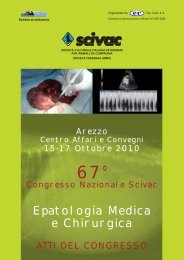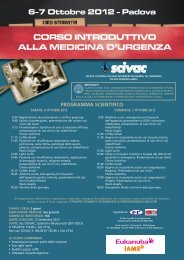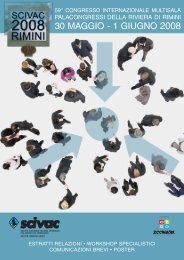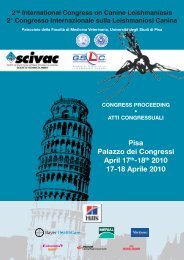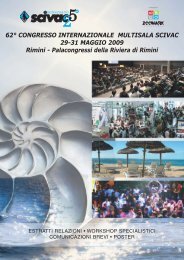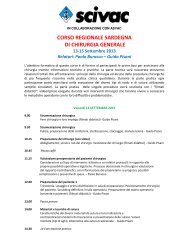68° Congresso Nazionale SCIVAC: Le domande più frequenti in ...
68° Congresso Nazionale SCIVAC: Le domande più frequenti in ...
68° Congresso Nazionale SCIVAC: Le domande più frequenti in ...
You also want an ePaper? Increase the reach of your titles
YUMPU automatically turns print PDFs into web optimized ePapers that Google loves.
<strong>68°</strong> CONGRESSO NAZIONALE <strong>SCIVAC</strong> 11-13 Marzo 2011 - Milano<br />
LE DOMANDE PIÙ FREQUENTI IN RIPRODUZIONE CANINA E FELINA<br />
Tutto quello che i vostri clienti osano spesso chiedere e a cui voi non sapete rispondere<br />
14 th EVSSAR Congress - Advances <strong>in</strong> Fel<strong>in</strong>e Reproduction - March 11 th 2011<br />
Suppression of oestrus cycle is one of the most frequent cause of consultation<br />
<strong>in</strong> veter<strong>in</strong>ary cl<strong>in</strong>ics. It may be surgical or medical. Ideal contraception<br />
has to be safe, effective, easy to perform and accepted by pets owners <strong>in</strong> its<br />
practical use but also <strong>in</strong> case of undesired side effects.<br />
More recently, protocols lead<strong>in</strong>g to oestrus <strong>in</strong>duction have been asked by<br />
breeders.<br />
1. SURGICAL PREVENTION OF OESTRUS<br />
1.1. OVARIECTOMY VERSUS OVARIO-HYSTERECTOMY<br />
All studies (see review by Van Goethem et al. 2006) show that ovariectomy<br />
alone is enough to prevent any further risk of uter<strong>in</strong>e diseases. Once the<br />
ovaries have been removed, there is no risk of further pyometra or endometritis.<br />
On the contrary of what is often said, ovario-hysterectomy (OVH) doesn’t<br />
seem to <strong>in</strong>crease the risk of ur<strong>in</strong>ary <strong>in</strong>cont<strong>in</strong>ence. It is therefore up to the<br />
operat<strong>in</strong>g veter<strong>in</strong>arian to choose the technique he prefers, know<strong>in</strong>g of course<br />
that it is important to take <strong>in</strong>to consideration pa<strong>in</strong> and analgesia (OVH may<br />
lead to larger sk<strong>in</strong> <strong>in</strong>cisions?) and the fact that veter<strong>in</strong>arians spay<strong>in</strong>g bitches<br />
and queens tend to use more and more NSAI drugs and morph<strong>in</strong>e analogues.<br />
We may also note that more veter<strong>in</strong>arians perform m<strong>in</strong>imally <strong>in</strong>vasive<br />
ovariectomies through a coelioscopic approach.<br />
1.2. PREVENTION OF MAMMARY NEOPLASIA<br />
Until recently, progest<strong>in</strong>s were highly used <strong>in</strong> the bitch and <strong>in</strong> the queen to<br />
prevent oestrus. However, due to many side effects (see below), they have<br />
been widely replaced by surgical castration. Nowadays, most veter<strong>in</strong>arians<br />
recommend castrat<strong>in</strong>g bitches and queens at an early age, to prevent the occurrence<br />
of mammary tumours later <strong>in</strong> life. However, there is still a debate<br />
about the ideal age of castration. A found<strong>in</strong>g publication by Schneider et al.<br />
(1969) demonstrated that optimal prevention of mammary neoplasia occurs<br />
when bitches are ovariectomised before the first oestrus, when there has been<br />
no hormonal impregnation of mammary glands. Accord<strong>in</strong>g to these authors, a<br />
castration before puberty leads to a risk of develop<strong>in</strong>g mammary neoplasia<br />
which is only 0.5% of the risk of an <strong>in</strong>tact bitch. The risk <strong>in</strong>creases to 8% if<br />
the bitch is castrated between the first and second oestrus, and after the 2 nd<br />
38



